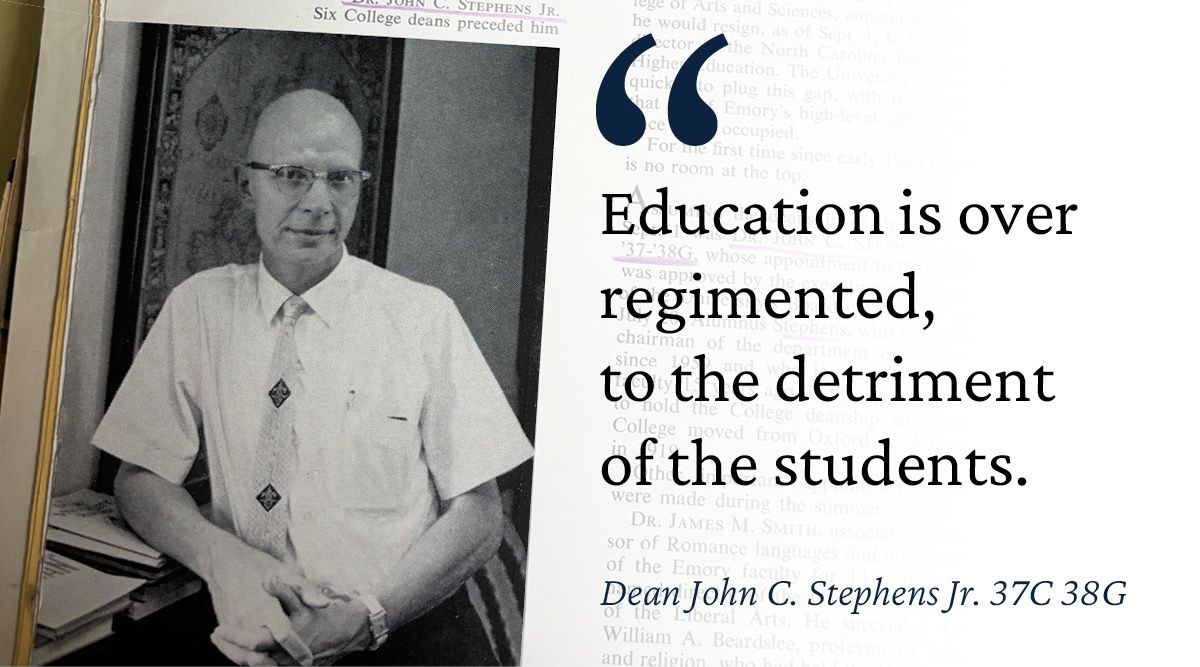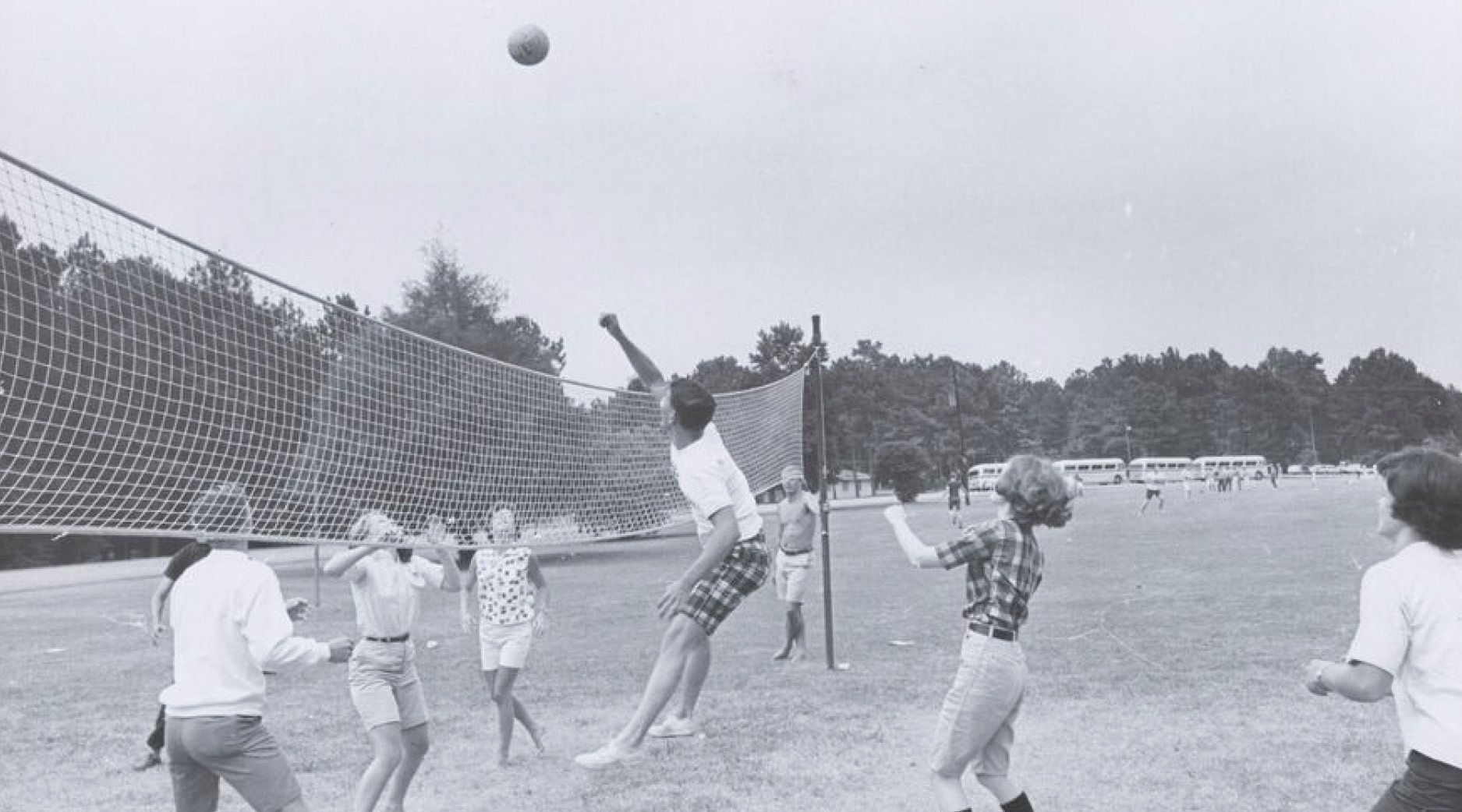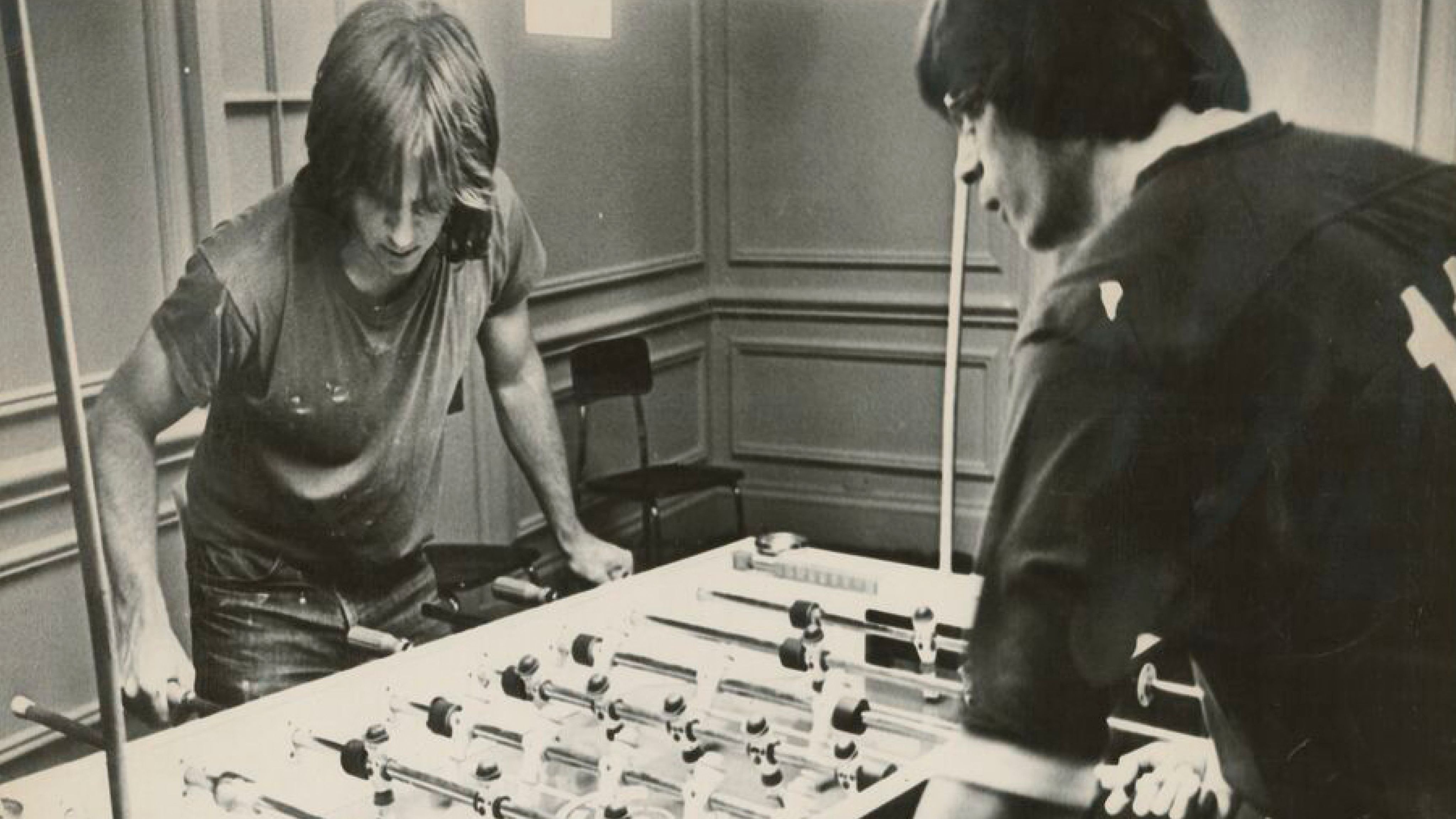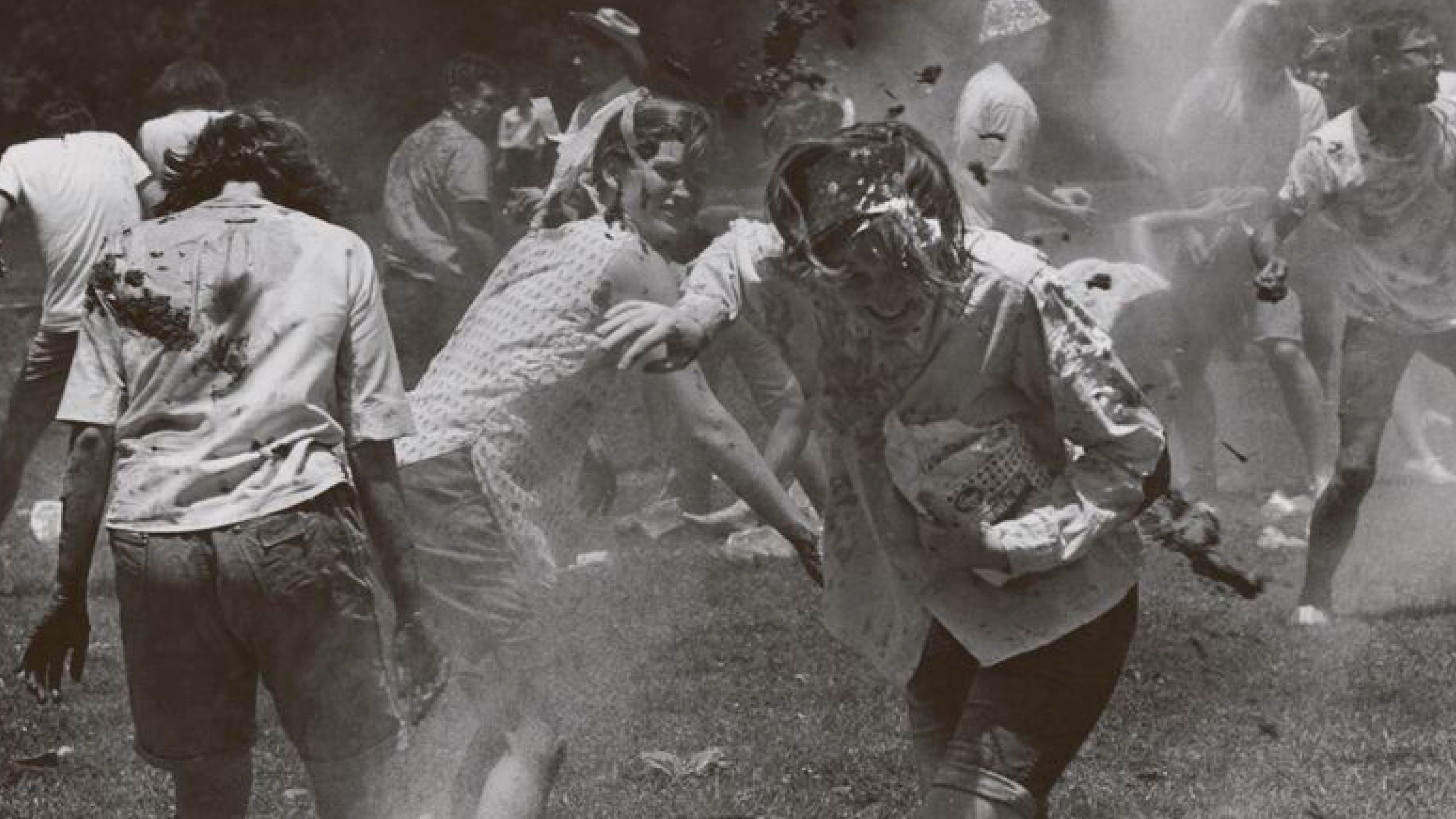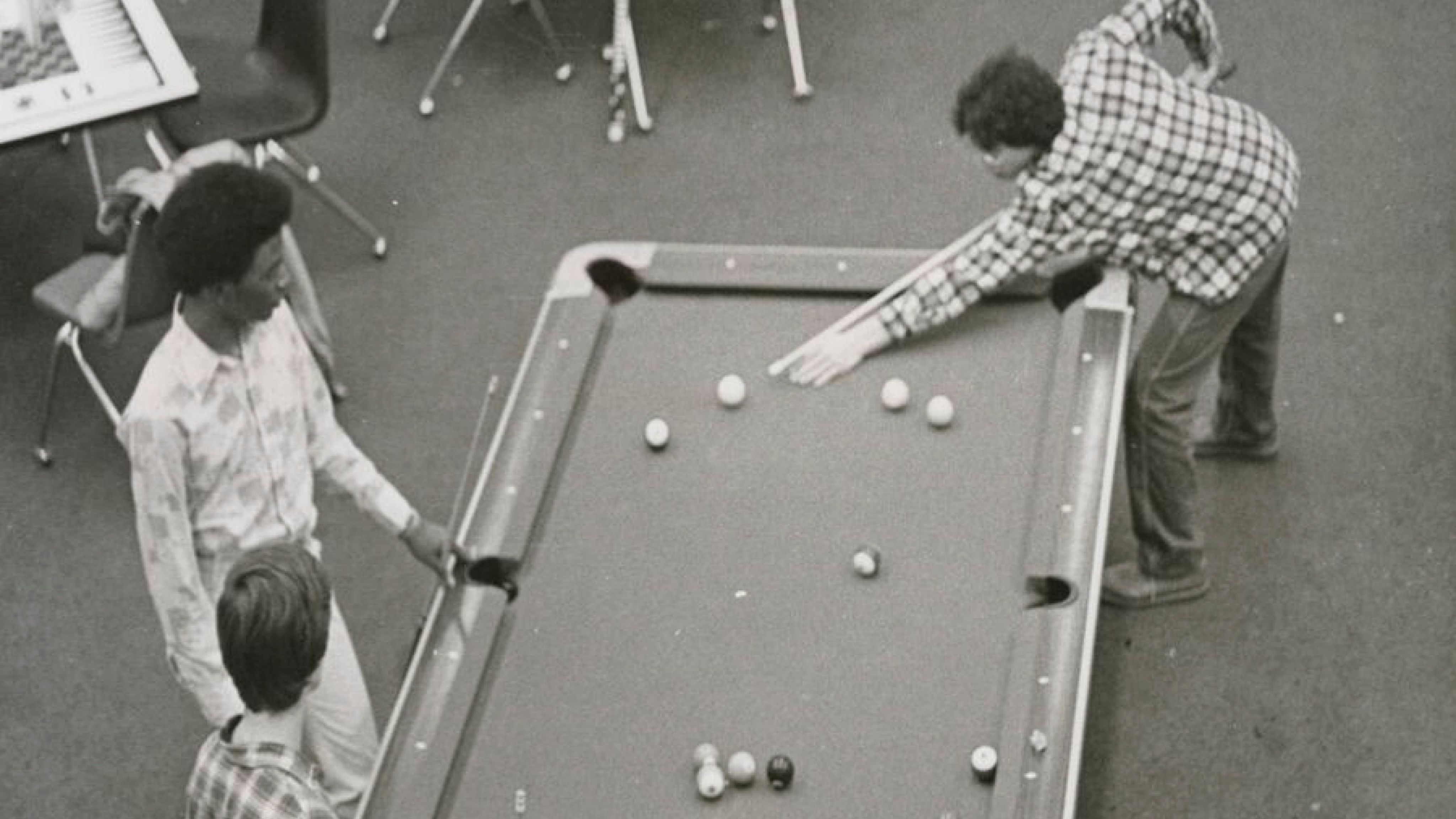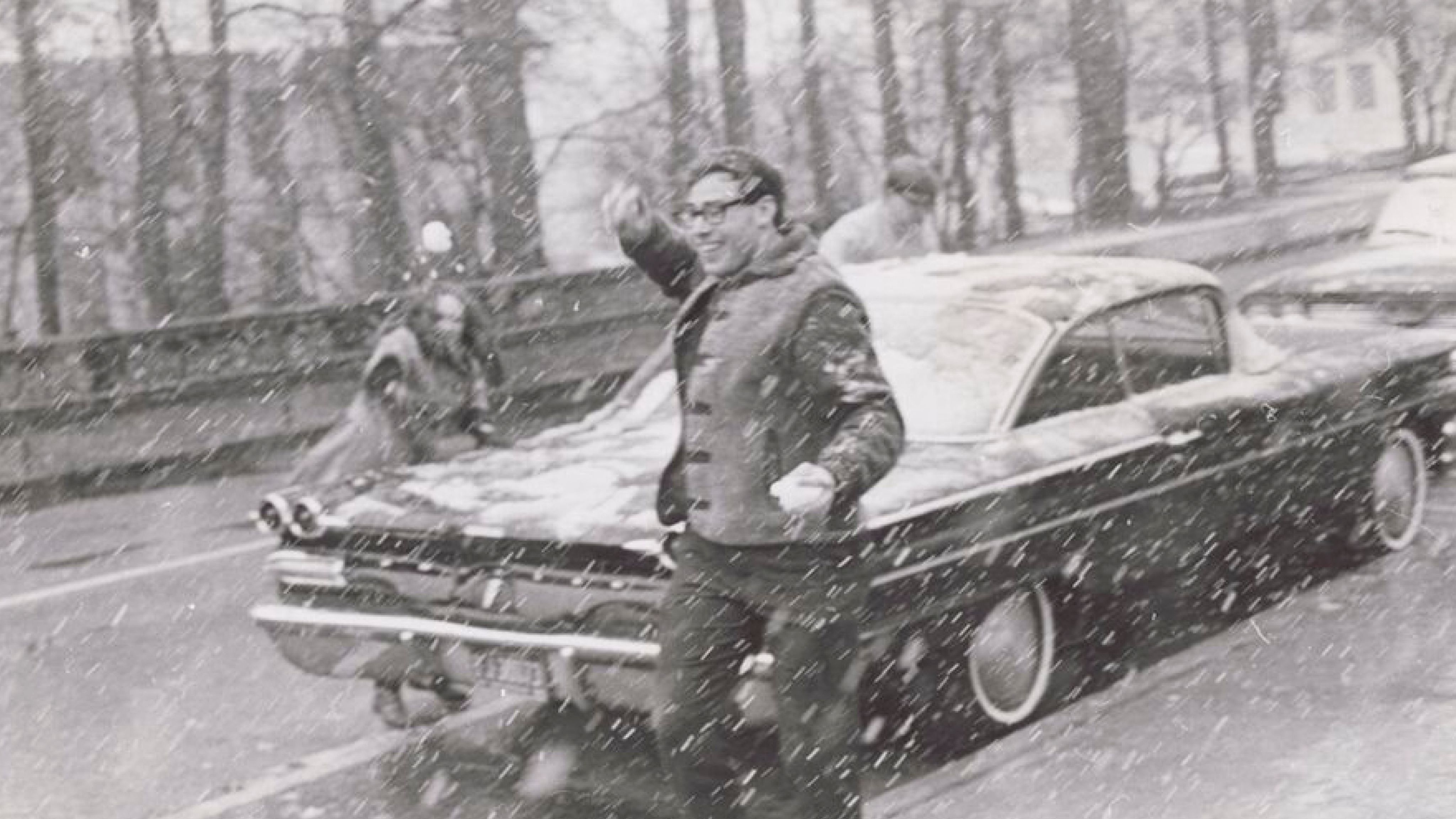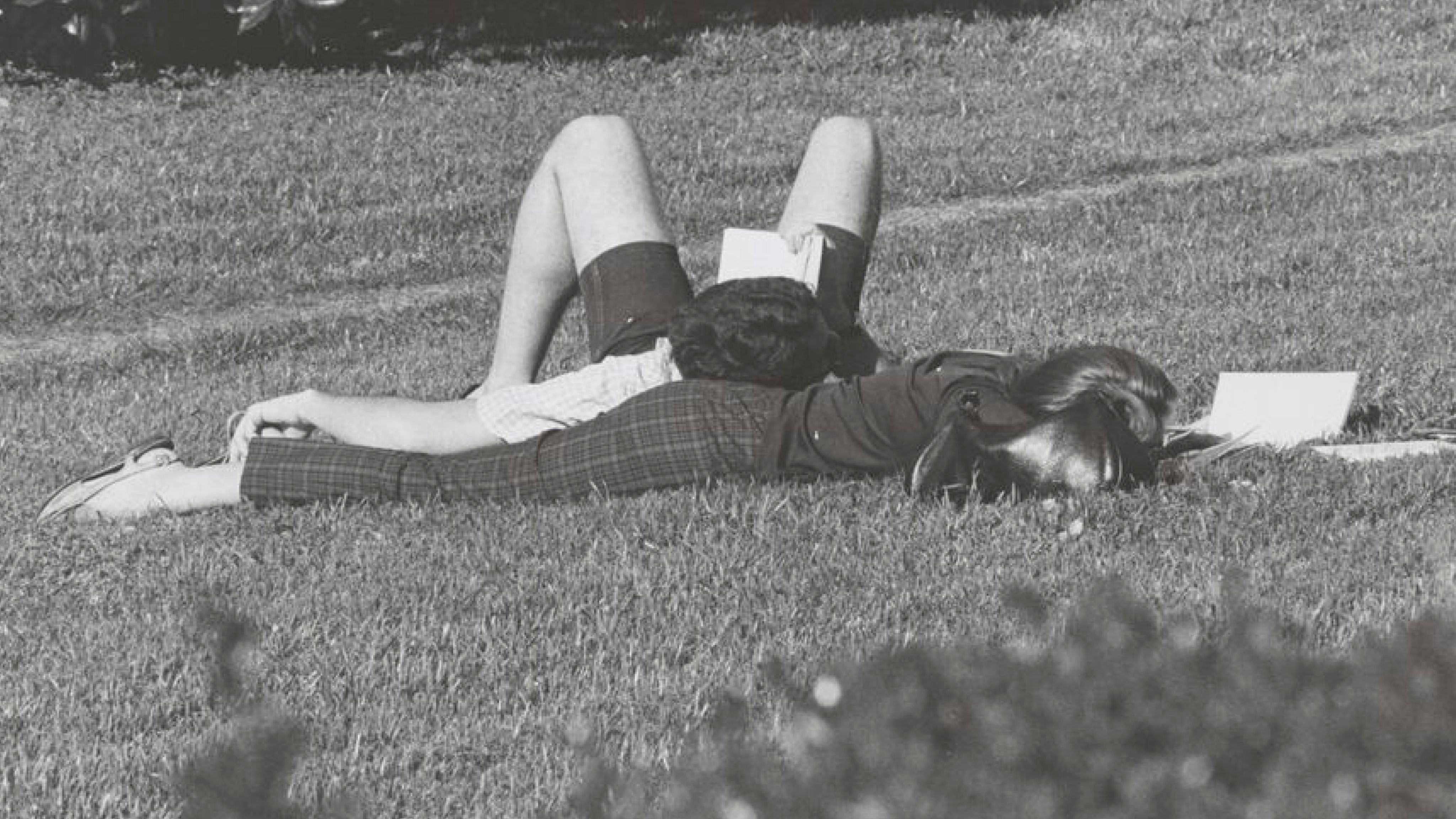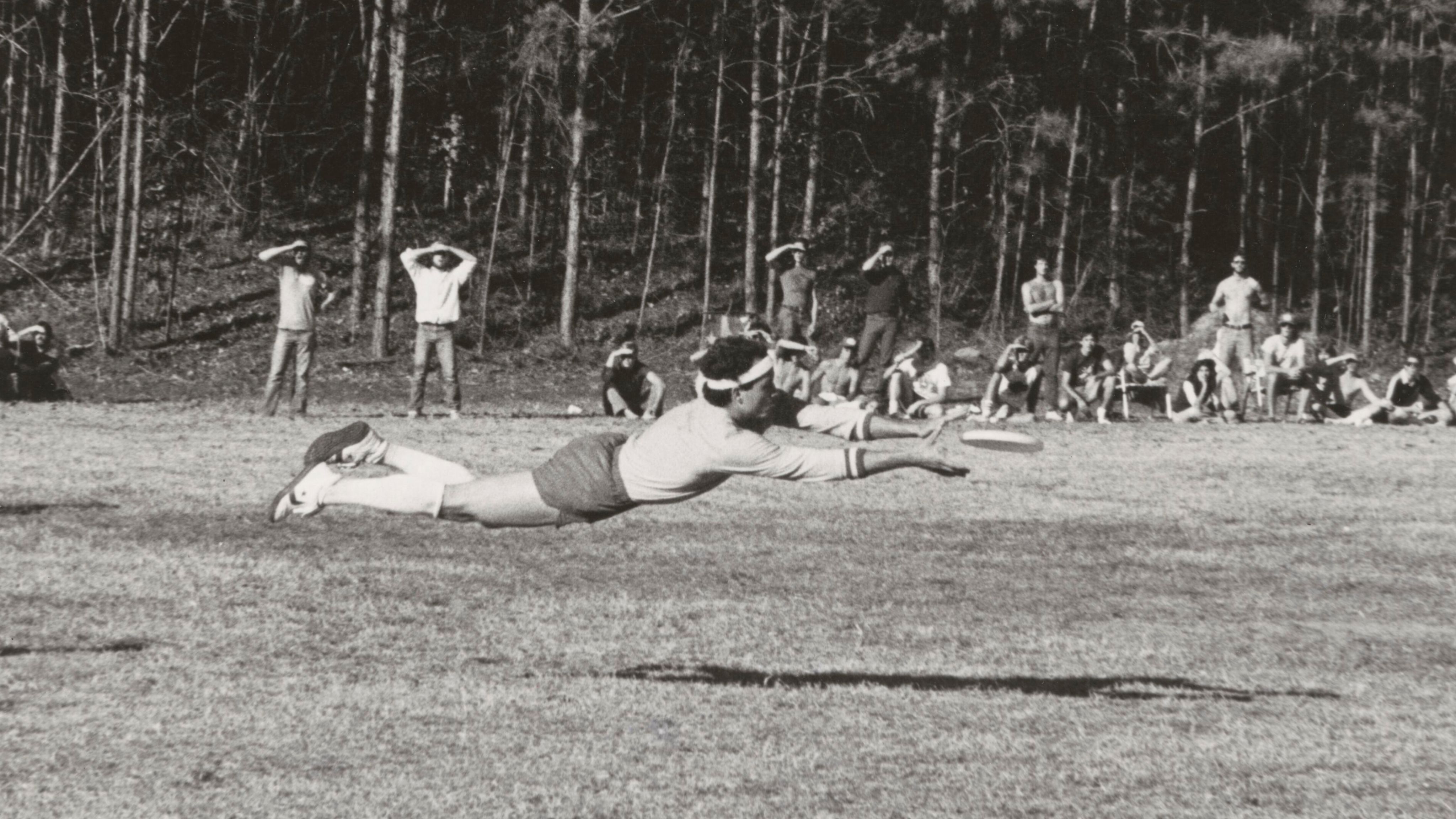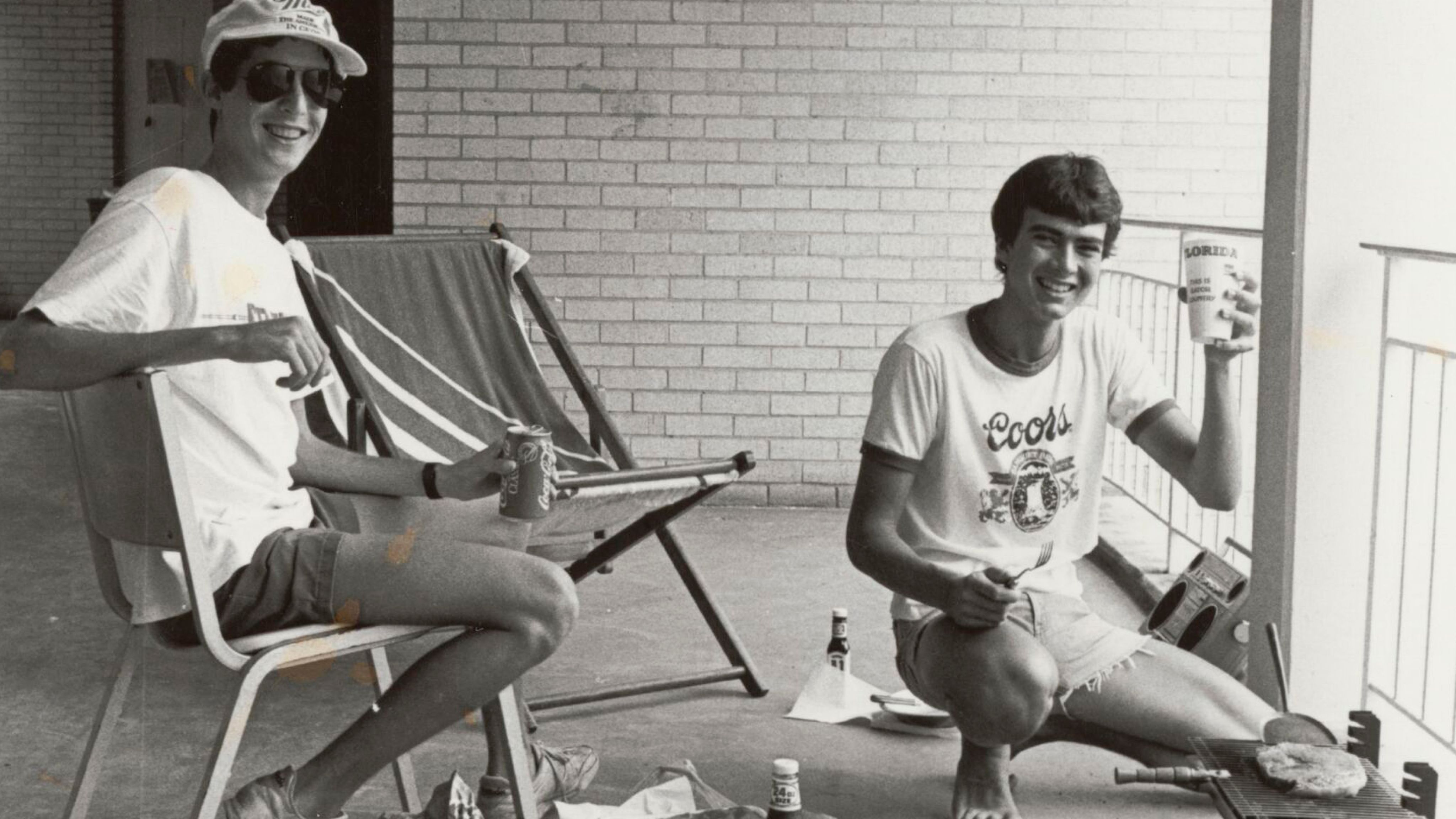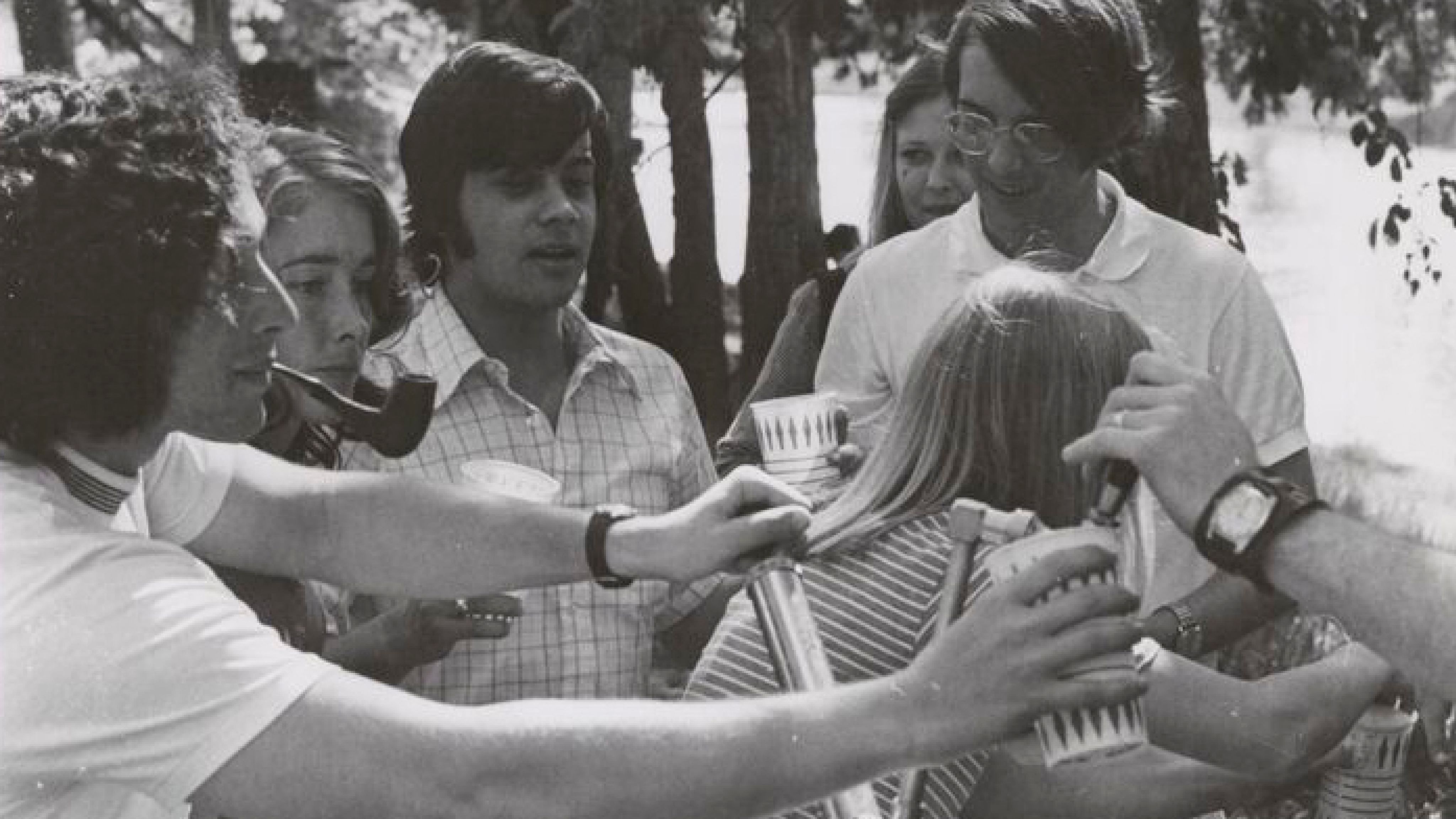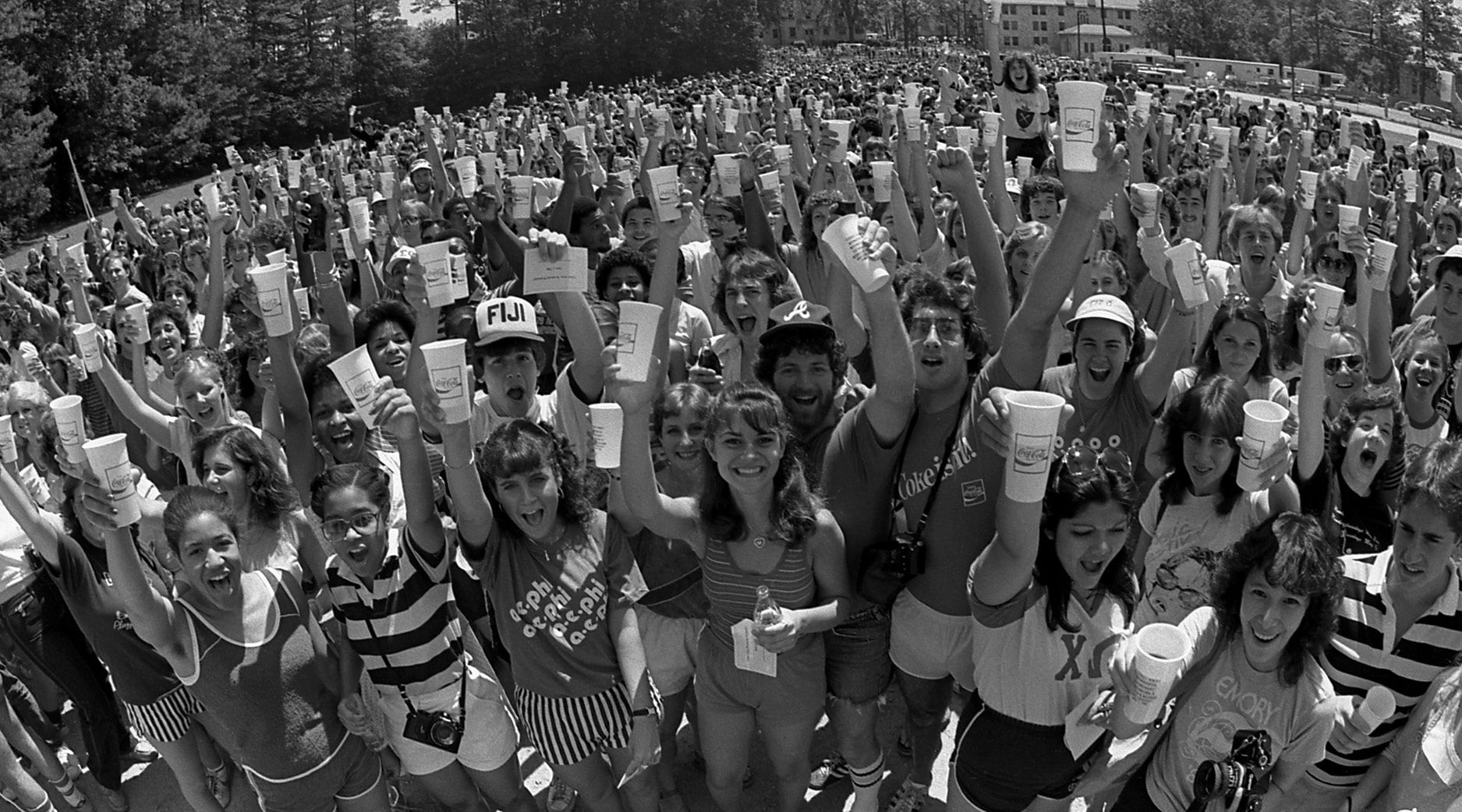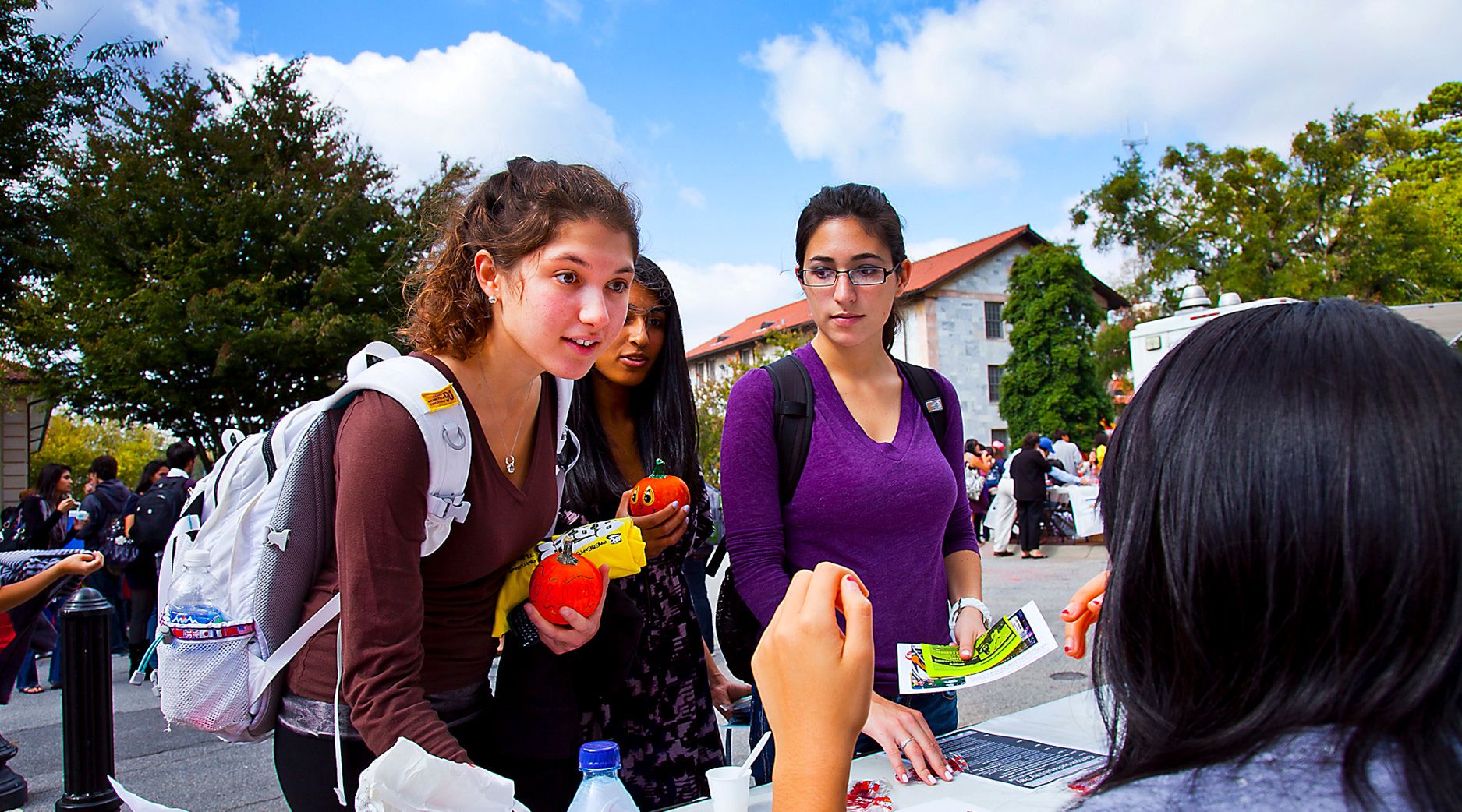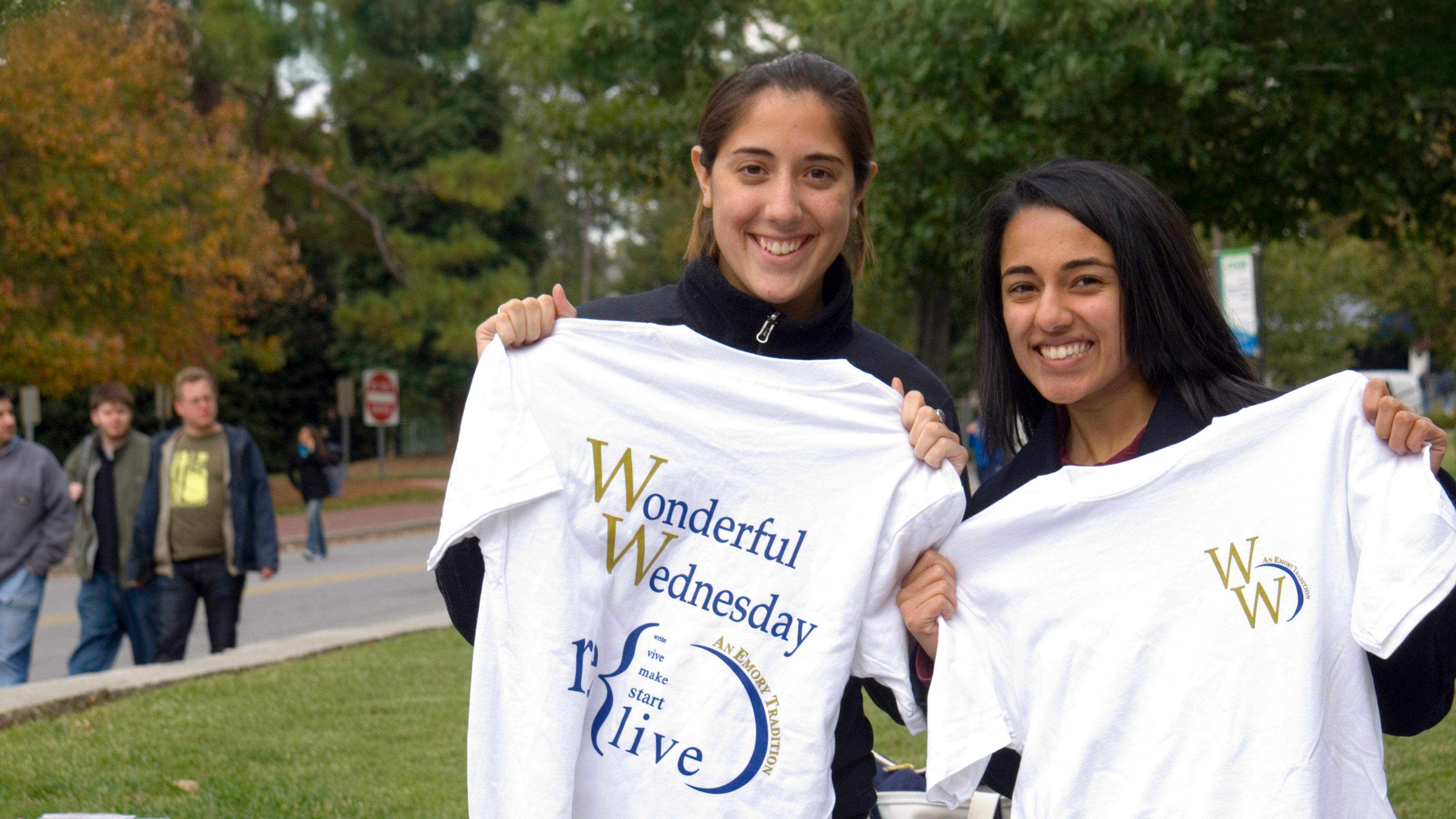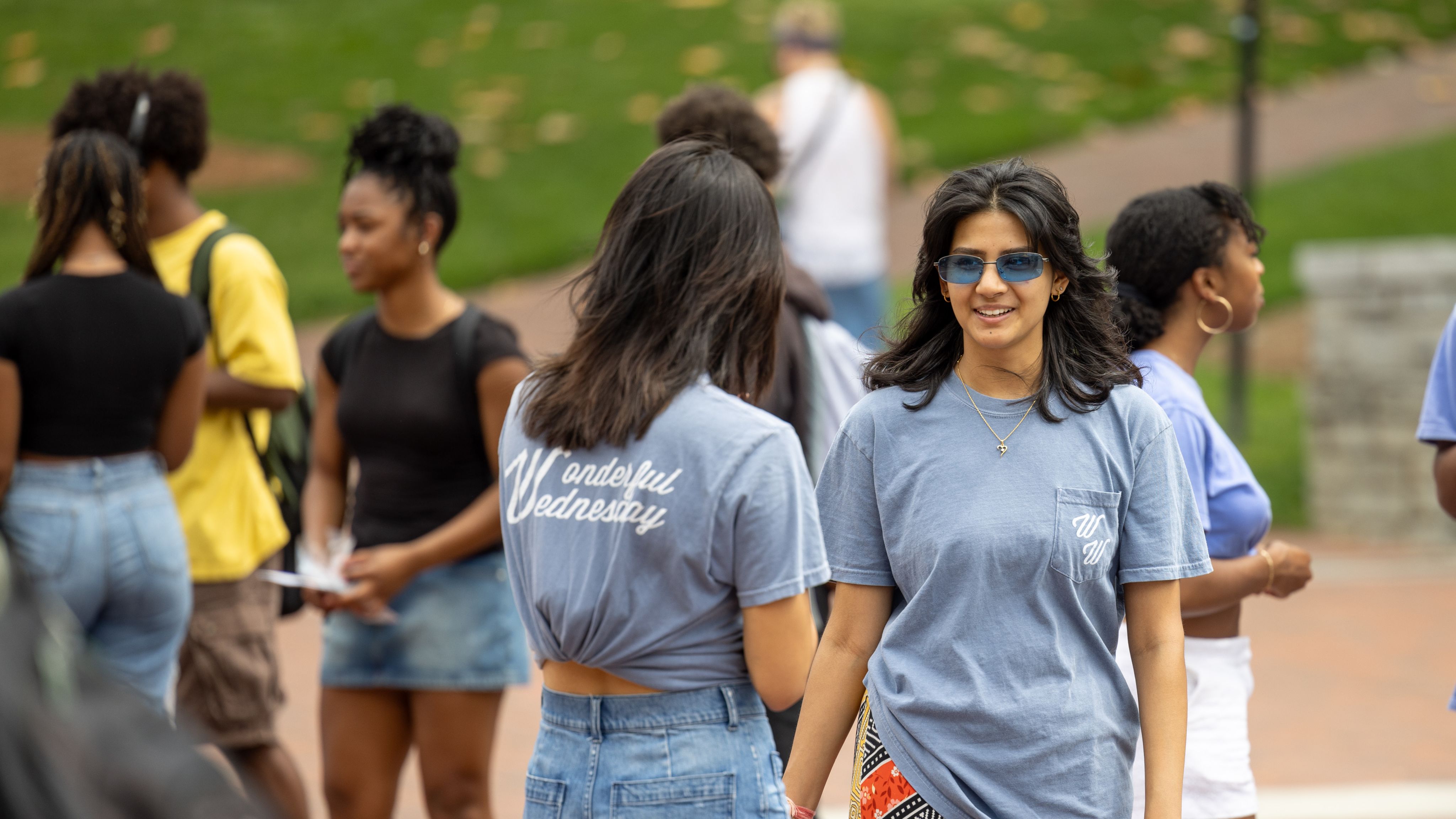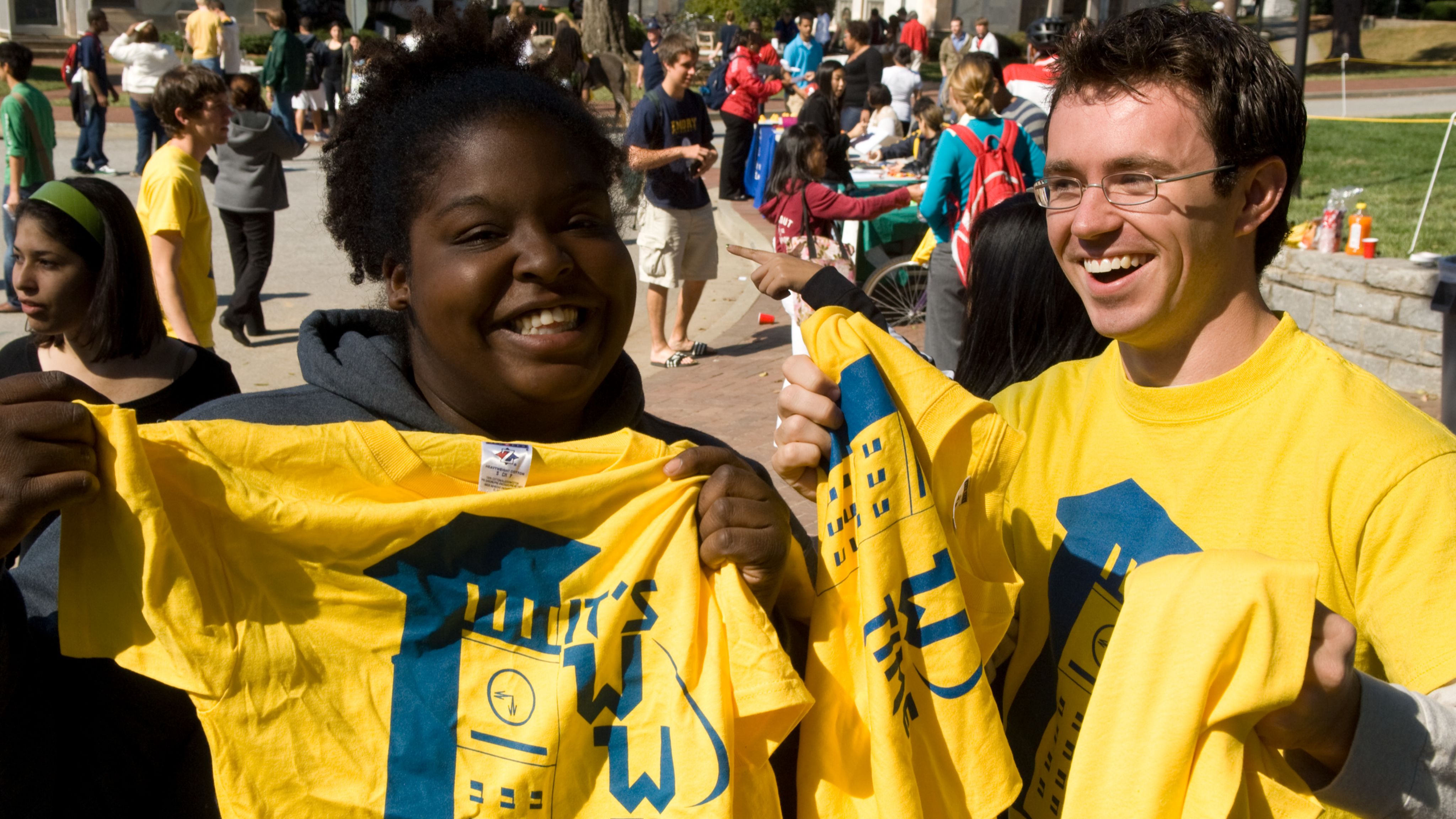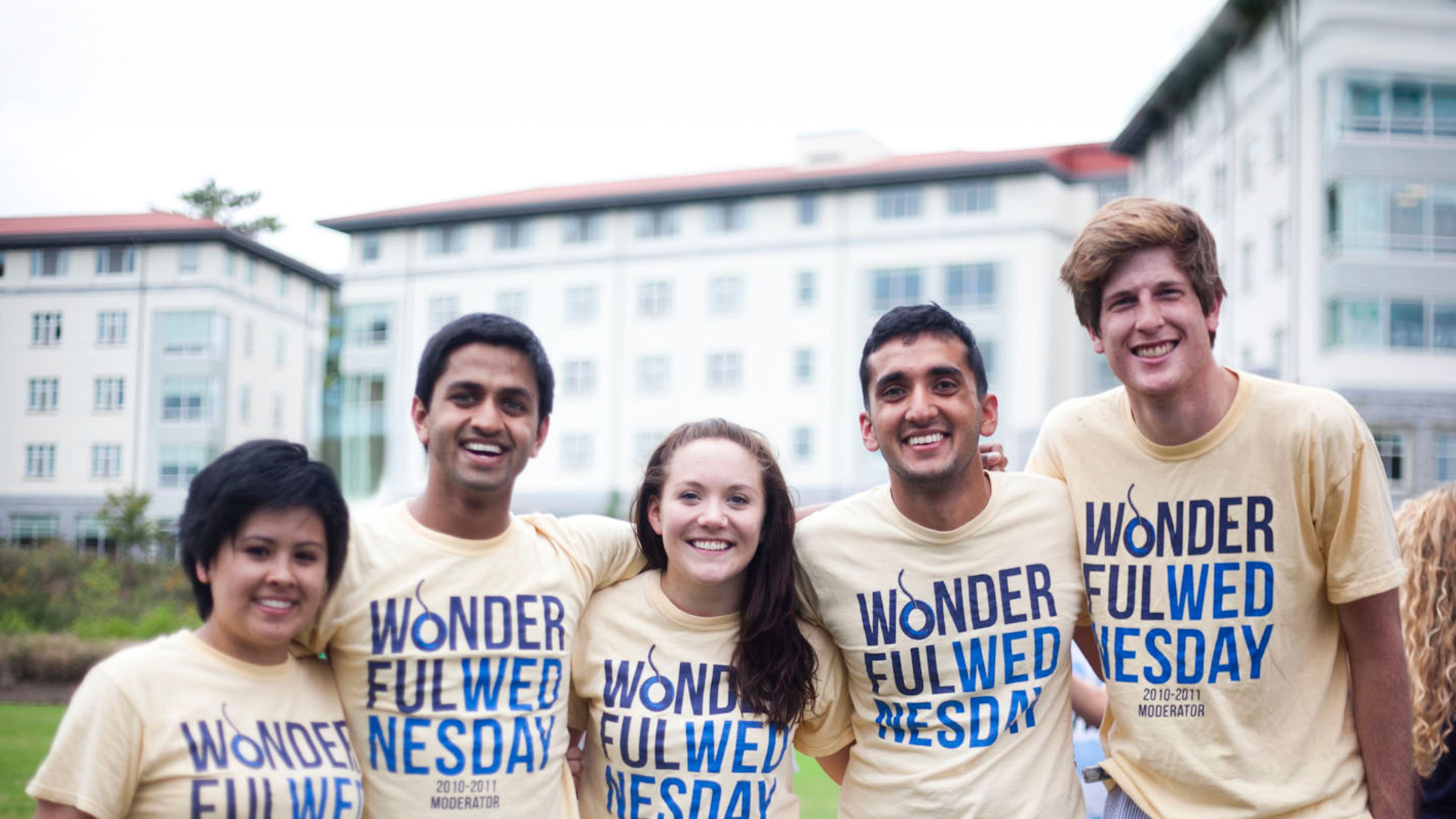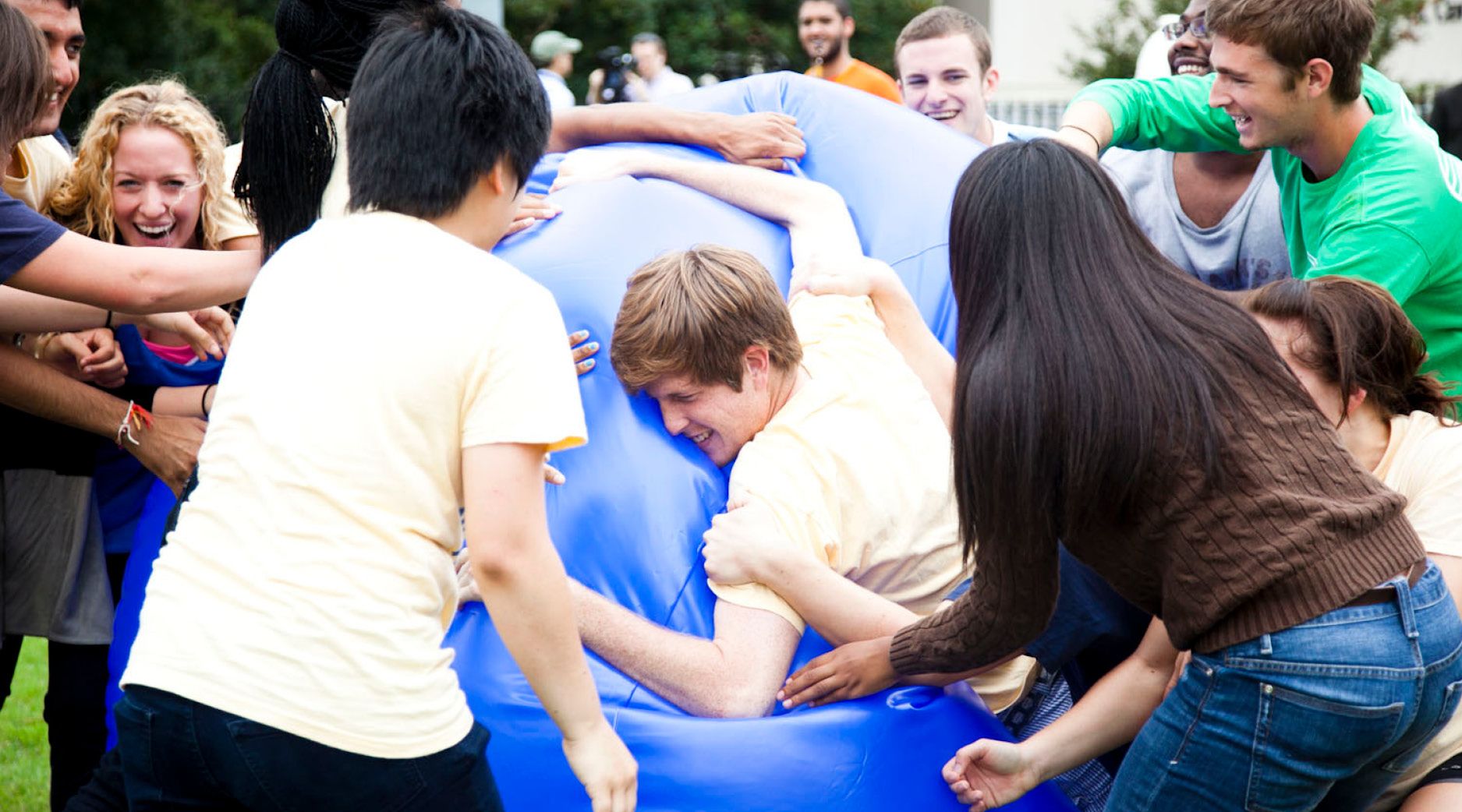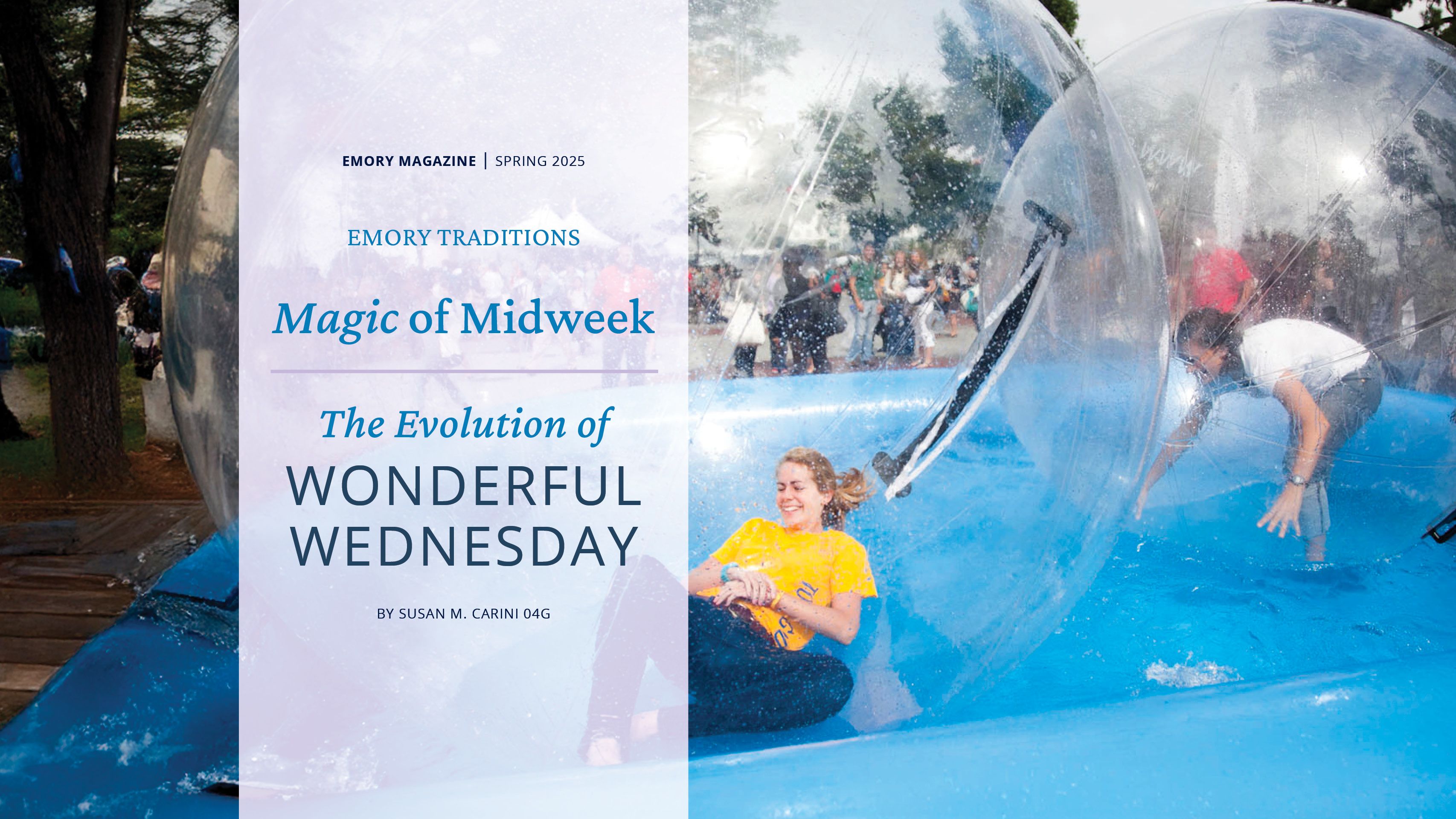
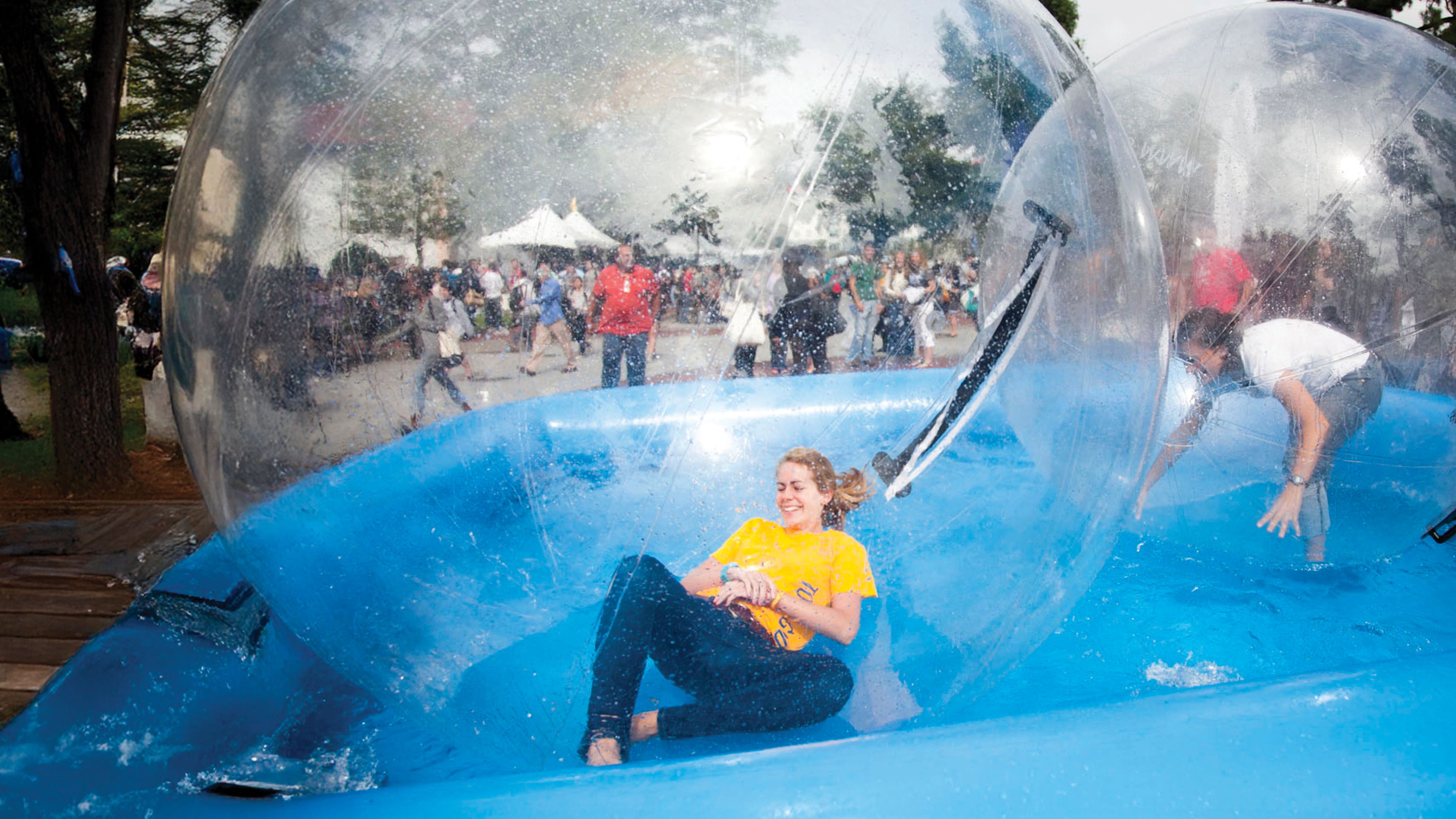
From an iconoclast dean’s bold experiment in the late 1960s to today’s student-led offering of activities and fun, Wednesdays at Emory continue to be wondrous.
Let’s do away with Wednesday classes on the Emory campus.
It sounds like wishful thinking from hopeful students. However, this unique educational experiment — one that attracted national attention in Time magazine — instead came from an Emory administrator.
The tradition known and deeply loved as “Wonderful Wednesday” was the brainchild of John C. Stephens Jr. 37C 38G, Emory’s undergraduate dean, in fall 1966.
An iconoclast, Stephens believed that “education is over regimented, to the detriment of the students.” To him, a midweek day for students to choose their activities and have more time to study would “reduce the tensions surrounding the desire to succeed,” an issue that was salient then and has remained so ever since.
Thus began the tradition of canceling undergraduate classes and asking student organizations not to meet on Wednesday. It would live on through the spring of 1982, after which Emory converted from the quarter to the semester system, which shortened the academic year from nine months to eight and made a five-class-day week necessary for accreditation.
A Bold Idea Reflective of the Times
Mandy Graves Rough 73C first heard about Wonderful Wednesday from an admission counselor visiting her high school. “That sounds pretty good,” she recalls thinking, and Ginger Cain Smith 77C 82G agrees, saying: “When I was looking at colleges, Wonderful Wednesday made Emory distinctive and appealing.”
According to Smith, “Wonderful Wednesday made Tuesday night almost like Friday,” a reference to the fact that sororities and fraternities moved their chapter meetings to Tuesday nights, followed by “mixers” at iconic gathering spots such as Moe’s & Joe’s and Manuel’s Tavern.
Both women studied on Wednesday, did laundry, hung out with friends and occasionally pursued sorority service projects. Other students used the day to be part of community organizations, work part-time jobs, attend tutorial programs, research term papers, read unassigned books, take part in athletics and get to know professors better.
Wonderful Wednesday was a bold idea reflective of the times. Rough describes a campus that, within her first year, seemed to shed its old skin.
“Arriving in fall 1969, we dressed up every day for class — skirts for the women,” she says. “We had a monitor in Harris Hall signing us in and out. No boys were allowed in the girls’ dorm.”
And then the vibe flipped. “By spring semester, we wore jeans and T-shirts. We no longer signed in and out. It was like night and day. Students had pushed for greater freedoms,” she says, and Wonderful Wednesday fit that campus culture perfectly.
A 1966 Atlanta Journal-Constitution article described the fourth Wednesday after the practice took hold: “The library was crowded, parking spaces were scarce, the cafeteria buzzed with conversation, the gym and athletic fields strained to take the load.”
Volleyball games and other fun pursuits became a midweek mainstay after Wonderful Wednesday was implemented from 1967-1982 on the Emory campus.
Volleyball games and other fun pursuits became a midweek mainstay after Wonderful Wednesday was implemented from 1967-1982 on the Emory campus.
In a survey, 96% of students and 83% of faculty supported Wonderful Wednesday, with one-third of the latter reporting that “students are better prepared, show greater independent thinking … and come to class more often.” And indeed, more students made the dean’s list and fewer were put on academic probation.
At moments, Stephens seemed to imply, with a wink, that he might go further. To one reporter, he said, “We might just take off two days a week, or maybe three.”
Suffice it to say that it was a tradition easy to get used to and hard to part with. Smith went on to a longtime staff position with the Emory Libraries and recalls, “The first Wednesday that I got up to go to work, I laughed to myself, ‘This isn’t going to do at all.’”
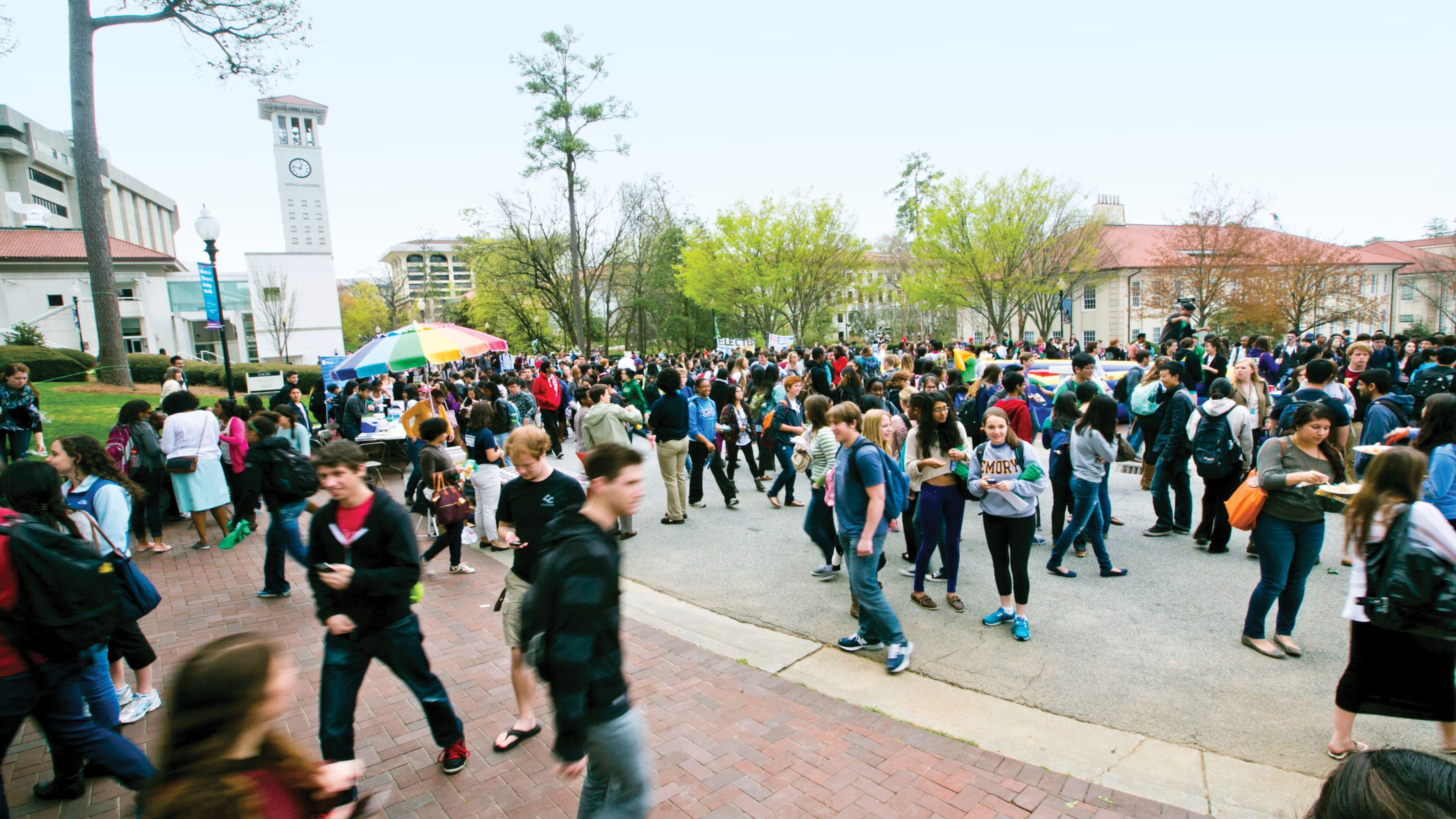
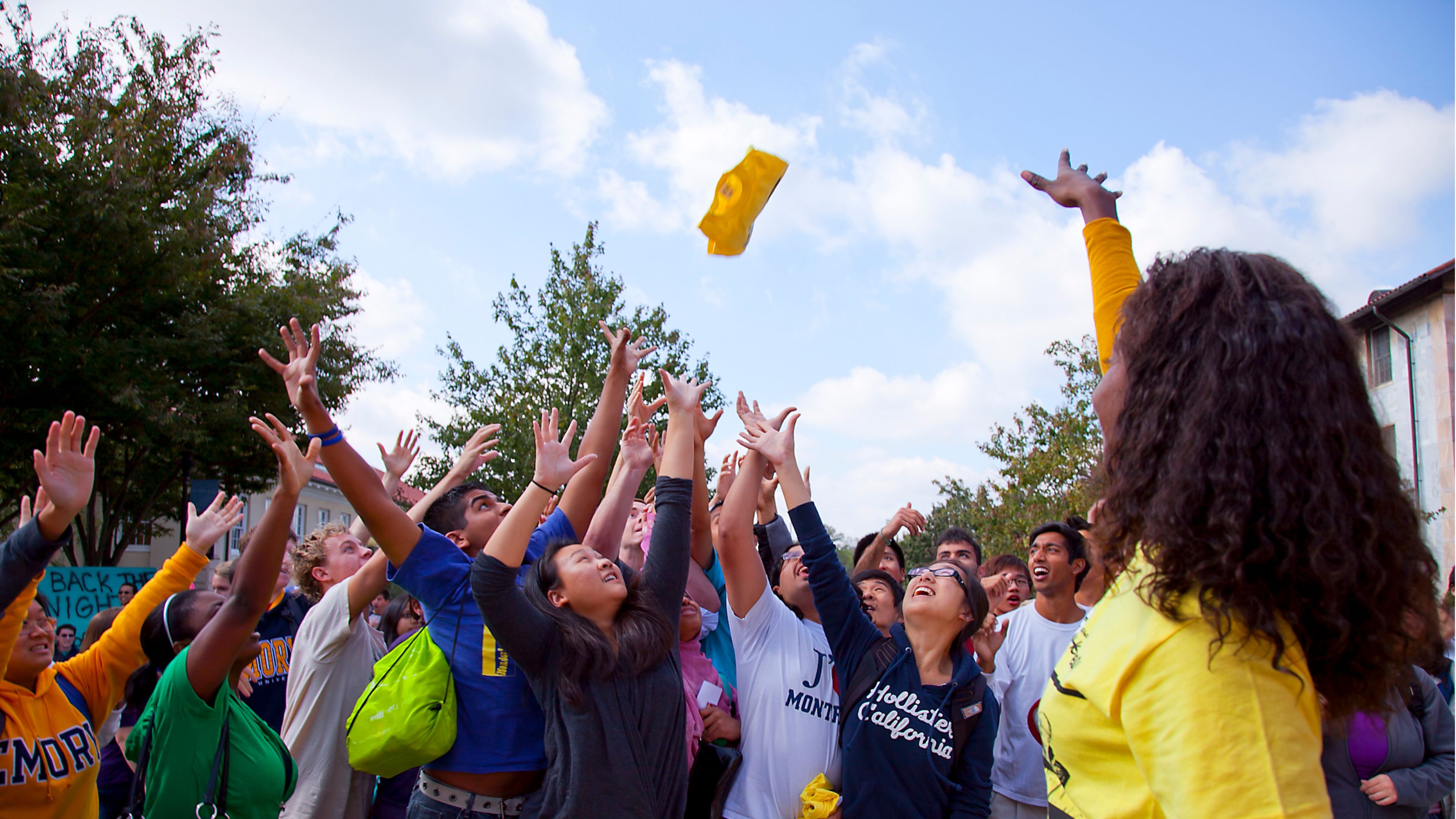
Reimagining the Tradition
With the imminent switch to the semester system, Wonderful Wednesday received a fond farewell that final spring quarter as 2,283 students gathered in front of the gym just after noon on June 2, 1982, setting a Guinness World Record for the largest nonalcoholic toast and beginning a new tradition, the Coke Toast.
The first Coke Toast was held in June 1982 as a way to say goodbye to the end of Wonderful Wednesday, at least for the time being.
The first Coke Toast was held in June 1982 as a way to say goodbye to the end of Wonderful Wednesday, at least for the time being.
Wednesdays turned into just another regular day of classes until 2005, when alumni and students from Ducemus started talking with administrators about reviving Wonderful Wednesday. One of Emory’s seven secret societies, Ducemus is led by senior honor students who describe their mission as “improving the Emory community by promoting loyalty, wisdom, integrity, tradition and vision.”
A Ducemus alum says, “The goal was to bring back something uniquely Emory that would unite diverse groups and different social scenes, while updating the tradition for this era.” There was also a desire for the new iteration of Wonderful Wednesday to be student-led.
After more than a year of planning, an unusual email message hit the in-box of Kristen Hays Berthelotte 06C, marked “TOP SECRET — OPEN WITH CARE” and “DO NOT SHARE INFO.”
It was from Ducemus and went on to say: “We have been watching you and admire you for all you have done at Emory. You lead by example.” The long and short of it: Berthelotte had been tapped to be the first head moderator for a revived Wonderful Wednesday.
One of the mainstays of modern Wonderful Wednesday is the ability for student organizations to set up spaces along Asbury Circle to promote their activities.
One of the mainstays of modern Wonderful Wednesday is the ability for student organizations to set up spaces along Asbury Circle to promote their activities.
Cue the Mission Impossible music. There was precious little time to pull events together for spring 2006. But the writers of this curious memo clearly knew her skills at organizing — Berthelotte was an orientation leader, tour guide and tour-guide trainer, and just happened to be writing an honors thesis on poet Seamus Heaney.
“I was tickled and thought it would be fun to be part of something that was secret,” she recalls.
Working with a tiny budget of around $2,000, Berthelotte and a team she pulled together — Kristina Garcia O6C, Chris Jayne 06C, Badri Modi 06C, Geoff Pallay 06C and Allison West 07C — got right to it. The idea was to stage a “quirky, grassroots effort to bring people together on campus, revive a tradition that had been beloved and build a new tradition,” she says.
These busy juniors and seniors impressively mounted four events that semester. To give a flavor for what they accomplished, the first March event featured the a cappella group Aural Pleasure and a wax-a-thon. The latter was “very entertaining as a few brave guys volunteered to get their backs and chests waxed publicly,” says Berthelotte.
In close succession came an event with an Indian theme featuring a Bhangra dance-off competition, the joyous spraying of colored powders to celebrate the Hindu festival of Holi, pie throwing (including at administrators) and a meal of samosas and grilled burgers served up by Emory chef “Pasta John.”
Just one thing backfired. At 4 a.m. before one of the events, Berthelotte and her squad “forked” the Quad, using plastic forks to create the huge letters “WW.” They had permission to do so, but Facilities apparently didn’t get the memo and removed the forks before anyone saw them.
Thinking back on what she set in motion, Berthelotte says: “Attendance at the new Wonderful Wednesday was good. Having campus groups helped because people came out to support their friends. I was proud of what we put together, and it was a great way to finish my years at Emory.”
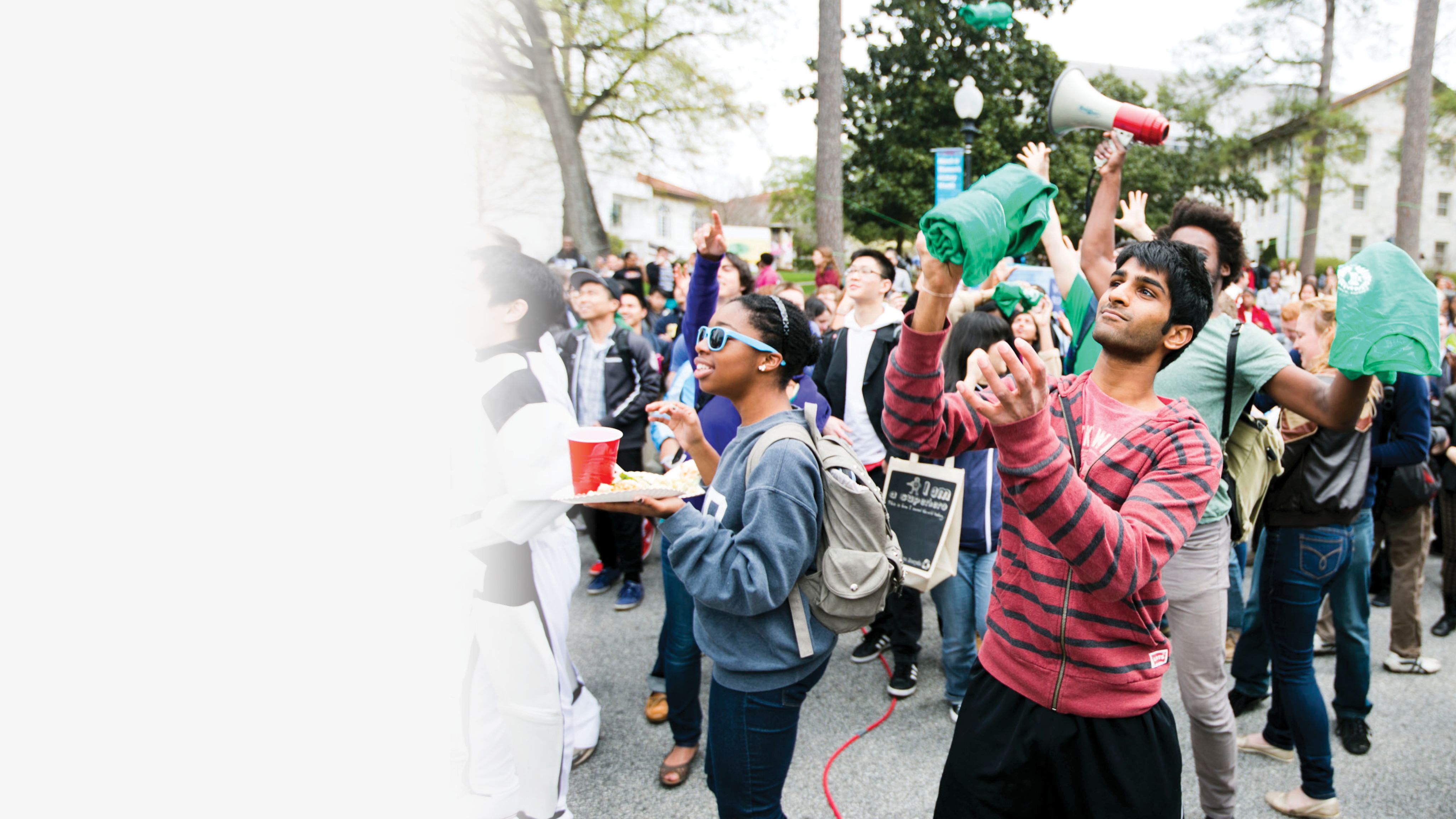
A Midweek Treat for All Students
Fast-forward: this “new” Wonderful Wednesday seems as if it always has been part of life on campus. Smith, who watched the tradition’s return as an employee, observes: “It is really hard to create traditions, especially as Emory has gotten larger and more dispersed. But on a college campus, your runway is not that long. If you can do something for two or three years, suddenly there is a sense that we have always done it that way because the student body turns over so quickly.”
Today’s Wonderful Wednesday honors all the values the tradition has stood for — engagement with the life of the campus and with each other — while taking some different turns.
For one, the operation has grown. A lot.
Angela Sarmiento 25C and Sophia Brittain 25C are this year’s head moderators, working with some 62 moderators and six committees — merchandise, food, drinks, publicity, sustainability and bonding. As was the case with Berthelotte’s crew, these moderators already contribute significantly to Emory organizations, but they feel honored to have been “tapped” to be part of Wonderful Wednesday. It remains the case that one cannot apply.
“It is a huge honor to continue the legacy of Wonderful Wednesday and be one of the two main point people each week,” says Brittain.
According to Sarmiento, “Wonderful Wednesday has a special air about it. Everyone on the programming side is so involved on campus and so passionate. We all have a similar energy that creates a positive, uplifting community.”
Student organizations often set up tables on Wonderful Wednesday to share information about events and membership.
Student organizations often set up tables on Wonderful Wednesday to share information about events and membership.
Every Wednesday in Asbury Circle beginning at noon, there is food, music, merchandise, fellowship and the chance to learn more about student clubs; any recognized student organization can table at the event to create awareness of their work and recruit new members.
In addition, Wonderful Wednesday After Dark — which was established in 2013 — especially speaks to older students. This nightime addition features all the aspects of a sunlit Wonderful Wednesday with the addition of a 21+ area for students who bring proper IDs.
Both the daytime and evening activities often rely on themes and welcome all students for a chance to connect — for example, Exam Jam (featuring live musical performances), a combined Pride/Hispanic Heritage Month, Take a Paws (providing opportunities to snuggle with puppies), World Kindness Day, a celebration of Emory Arts and Present Your Hustle, which highlights Black student vendors during Black History Month. Campus Life also sponsors special events throughout the academic year.

2006
2006
2024
2024
2008
2008
2011
2011
Ensuring Future Wonderfulness
Brittain appreciates Emory’s openness to all recognized student organizations having a face and voice at Wonderful Wednesday. Experience tells her that is not the case on all campuses. And she and Sarmiento are thankful for Lydia Washington, executive director of the Emory Student Center and an integral part of the Campus Life leadership team, who advises the group and is “phenomenal,” says Sarmiento, in troubleshooting the inevitable blips that arise with this much programming.
Sarmiento and Brittain are walking definitions of “hands-on,” with both somehow making time to come to every Wonderful Wednesday event. As a biology major and predictive health minor, says Brittain, “My classes are not in the center of campus. Coming every week allows me to see the friends I have made over the course of my four years — listen to music, talk, laugh and be aware of the amazing things that happen here because of student energy and passion.”
Silly events and contests, like this pushball match from 2011, sometimes make an appearance on Wonderful Wednesdays to add some midweek humor.
Silly events and contests, like this pushball match from 2011, sometimes make an appearance on Wonderful Wednesdays to add some midweek humor.
“In theory, it is not necessary for us to be at every event. But this is our baby,” Sarmiento adds.
With a new class of moderators just coming on board, Brittain says, “They and all the moderators deserve a shoutout. Whatever it takes for the thousand details we run down every week — finding a drum set, creating a flyer — they put in the additional work to make our community as dynamic as it is.”
“It cannot be an accident that so many Emory tours come by during Wonderful Wednesday,” Sarmiento observes.
From the 1960s through today, university admission counselors — online and during visits — have understood the value of invoking the tradition that, for all its changes, has remained quite wonderful.


Want to know more?
Please visit Emory Magazine, Emory News Center, and Emory University.


